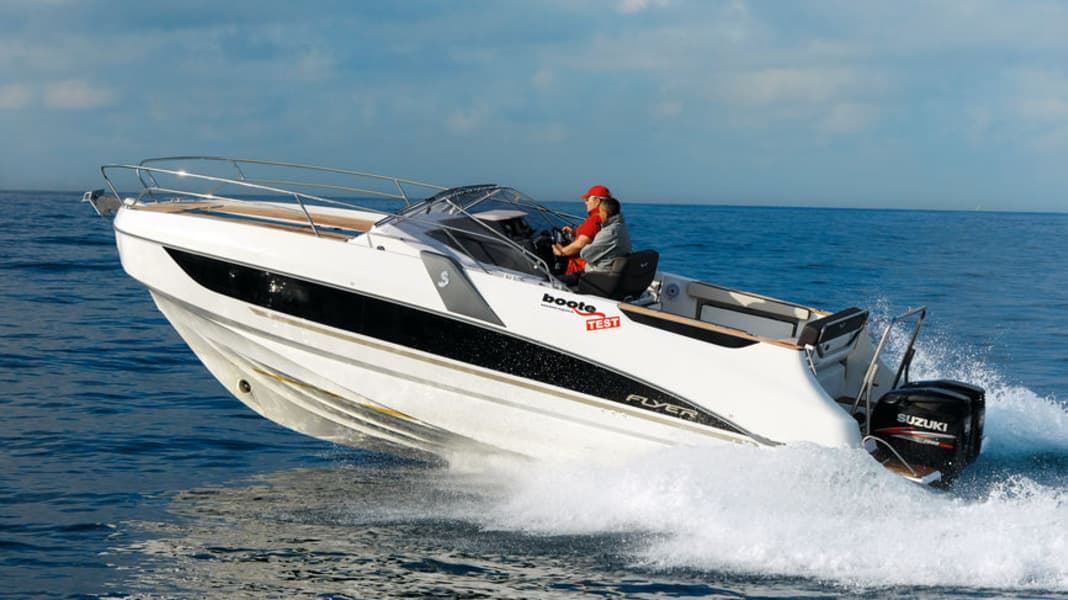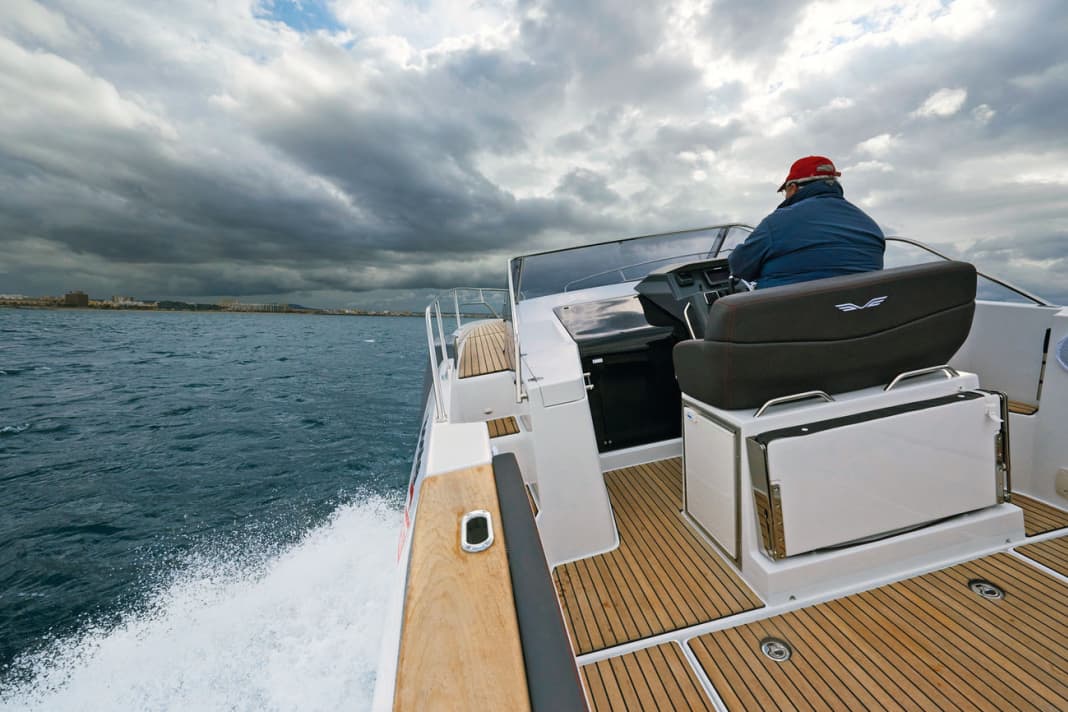
The French Bénéteau shipyard is adding the large Flyer models to its sports boat fleet. They are already available as Flyer 5, 6 and 7 in different versions in terms of the extension and superstructure in front of the steering position. All Flyers have the same hull, the "Air-Step-Hull".
As a result, the boat glides on a kind of air-water carpet, which, according to the shipyard, saves fuel and improves handling characteristics.






In terms of the exterior layout, the test boat shines with its large sunbed at the front and the variably customisable cockpit with seating and lounging areas. Those who like the If you want to trailer an 8.8 that is just under 3 metres wide, you should have it transported.
Flying and landing with theBeneteau Flyer 8.8
Two motors simplifyMooring and casting off manoeuvres. When one gear is engaged forwards and the other in reverse, the boat can be turned almost on the spot. With both gear levers in forward or reverse, a full circle measures about 1 ¼ boat lengths. Synchronised motors determine the directional stability, otherwise the bow thruster (extra) helps to keep the boat on course during longer reverse journeys and crosswinds.
In the harbour, we run both engines at a maximum of 1000 rpm, and 500 rpm more after leaving the harbour so that the waves generated by the boat do not interfere. The transition from displacement to planing speed is short, and apart from the reflections in the plastic windscreen and the fact that it is in our field of vision, we can see the boat from a distance.Tubular frame the view to the front is not obstructed by anything.
The smallest glide is 16 knots and we measured a maximum speed of 42 knots. After analysing the measurement data, which is based on the shipyard data, our test boat cruises economically at a speed of 23 knots.
The standard tank capacity is 400 litres; 200 litres more can be bunkered for an extra charge. In our case, the 400 litres or 600 litres of petrol (the values for the larger tank are in brackets) are good for a theoretical range of 131 nm (197 nm) plus 15% reserve at slow speed; at economical driving it is 129 nm (194 nm) and at full throttle 83 nm (125 nm) plus reserves.
So the test boat only fulfils our minimum range requirements with a 600-litre tank plus reserve - which means a downgrade for the standard tank.
Extreme manoeuvres such as slalom manoeuvres, manoeuvres of the last moment or tearing the rudder are not feasible in a hurry because the steering is stiff and requires more than seven turns from one side to the other.
You need both hands, but you have to let go of the control levers and lose control of the engines - the boatyard wants to think about a different steering system! If you manage to crank fast enough against the resistance, the boat will turn 180° thanks to Air-Step-Hull and air carpet curves of two to three boat lengths in diameter without rocking or hooking the hull.
If the curve diameter is less than four boat lengths, the propellers begin to ventilate, for which the hull construction plus the mounting height of the engines are responsible. WithRough water and waves ultimately determine the height and distance of the waves on the test boat, whether you drive over them at full speed or reduce your speed. Once you take off, you land noticeably but safely.
Engine, tank, electrics
Our test boat is equipped with two 250 hp Suzuki engines. The holding tank, batteries, main switch and 230 V fuse are all within easy reach under the outer cockpit floor flaps. The fuel tank and pre-filter are separated from the storage space in the centre of the boat, but are accessible from above through service hatches.
The pre-filters are fitted with sight glasses and drain taps, but there are no water alarm sensors. The fuel taps can be accessed through a service cover in theMotor sump. The easily accessible fuses are concealed behind a flap in the underfloor cabin.
Security
In an emergency, the test boat can also be motorised to glide! Operating the bathing ladder on the port side, under the cover of the attached bathing platform, seems a little awkward from the water.
At least there is a large grab handle. On the foredeck, which is more possible in the rear than on the passenger seat. The co-driver either has to reach behind him or lean forwards - neither of which is ideal.
What's more, the seat surface of theDriver/passenger bench seat too short; the mechanism that allows you to fold up part of it pinches your thighs because the padding is too soft. On the other hand, the lateral support is good.
The windscreen is tinted a little too dark and there is no windscreen wiper as this would scratch the material.
Living, cockpit and equipment
When descending into the living area, you need to keep your eyes open to avoid making a misstep on the narrow steps. The headroom in the cabin and the separate toilet room is due to the design. Light and air enter through the windows, escape hatch and portholes.
The seating area can be converted into a berth for two people by lowering the table, inserting the cushion and attaching a crossboard and cushion. The underfloor cabin has two further berths; however, the space available here is limited in terms of height. Anyone lying in the back has to climb over the person in front if they want to get in or out.
Including the floor storage compartment, there is no shortage of storage space in the cabin - as elsewhere on the boat. Between the forward and underfloor cabins, a piece of furniture with a built-in refrigerator serves as a shelf and provides additional storage space.
OneMini pantry with sink and gas cooker is located in the cockpit. In addition to the sink with shower fitting, the bathroom also has a pump toilet. The navigation lights, canopy and tarpaulin, which are approved in Germany, cost extra, which leads to a devaluation. The compass comes as standard and the depth sounder is part of the electronics package; both cost extra.
As far as the equipment is concerned, the boat is ready to go. The shipyard offers pre-installation, pre-rigging of engine instruments, gearstick and electrics; the dealer then only has to bolt the engine(s) to the stern. The list of accessories includes everything else needed for comfort - although there is no rubbing strake worthy of the name.
Technical data - Beneteau Flyer 8.8 Sundeck
- Shipyard: Bénéteau
- Type designation: Beneteau Flyer 8.8 Sundeck
- CE category: B - Outside coastal waters
- Material of hull and deck: Plastic
- Length: 9,00 m
- Width: 2,97 m
- Displacement: 2,46 t
- Price: 106.258,00 €

